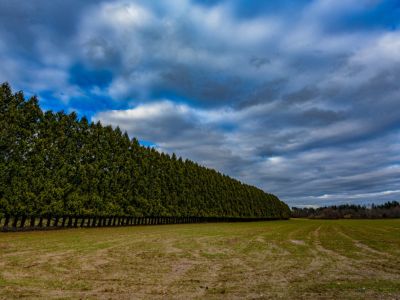Garden Windbreak Design
The best garden windbreak design incorporates up to four rows of trees and shrubs. It begins with a row of tall evergreens closest to the home, with rows of successively shorter trees and shrubs, both evergreen and deciduous, behind it. This design directs the wind up and over your home. The National Renewable Energy Foundation recommends planting the windbreak at a distance of two to five times more than the height of the closest trees. On the protected side, the windbreak reduces wind strength for a distance of at least ten times its height. It also has a moderating effect on the wind on the other side. You should allow 10 to 15 feet (3 to 4.5 m.) of empty space between rows within the windbreak. Multi-layered types of windbreaks are best suited to open rural landscapes. Read on for information about single-layered windbreaks for urban environments.
Plants and Trees to Grow as Windbreaks
When choosing plants and trees to grow as windbreaks, consider sturdy evergreens with lower branches that extend all the way to the ground for the row closest to the home. Spruce, yew and Douglas fir are all good choices. Arborvitae and Eastern red cedar are also good trees to use in windbreaks. Any sturdy tree or shrub works in the back rows of a windbreak. Consider useful plants such as fruit and nut trees, shrubs and trees that provide shelter and food for wildlife, and those that produce materials for crafts and woodworking. Cold air pools around the base of the shrubs on the windy side, so choose shrubs that are a little hardier than what you would usually need in the area.
How to Create a Windbreak in Urban Landscapes
Urban homeowners don’t have the space for rows of trees and shrubs to protect their home, but they have the advantage of nearby structures to help moderate the effects of strong winds. In the city, a single row of small trees or tall hedge shrubs, such as junipers and arborvitae, can be quite effective. In addition to a windbreak, you can insulate the foundation of your house by planting a dense row of shrubs spaced 12 to 18 inches (30 to 45 cm.) from the foundation. This provides an insulating cushion of air that helps regulate the loss of cooled air in summer. In winter it prevents frigid air and blowing snow from becoming trapped against the house.
Care for Windbreaks
It is essential to get the trees and shrubs off to a good start so they become sturdy plants that can stand up to strong winds for many years to come. Keep children and pets out of the area for the first year or two to prevent damage to the lower branches of young saplings. Water the trees and shrubs regularly, especially during dry spells. Deep watering helps the plants develop strong, deep roots. Wait until the first spring after planting to fertilizer the plants in your windbreak. Spread 10-10-10 fertilizer over the root zone of each plant. Use mulch to suppress weeds and grass while the plants become established.
